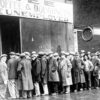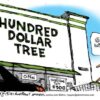Boys Town, Nebraska
![]()
Boys Town, Nebraska
25 languages
Tools
Coordinates:  41°15′21″N 96°07′45″W
41°15′21″N 96°07′45″W
From Wikipedia, the free encyclopedia
| Boys Town, Nebraska | |
|---|---|
| Village | |
| Boys Town water tower, March 2015 | |
| Location of Boys Town, Nebraska | |
Coordinates:  41°15′21″N 96°07′45″W 41°15′21″N 96°07′45″W | |
| Country | United States |
| State | Nebraska |
| County | Douglas |
| Government | |
| • Mayor | Maddie Hagan |
| Area[1] | |
| • Total | 0.95 sq mi (2.45 km2) |
| • Land | 0.91 sq mi (2.34 km2) |
| • Water | 0.04 sq mi (0.10 km2) |
| Elevation[2] | 1,224 ft (373 m) |
| Population (2020) | |
| • Total | 410 |
| • Density | 453.04/sq mi (174.97/km2) |
| Time zone | UTC-6 (Central (CST)) |
| • Summer (DST) | UTC-5 (CDT) |
| ZIP code | 68010 |
| Area code | 402 |
| FIPS code | 31-06015 |
| GNIS feature ID | 2398159[2] |
| Website | www.boystown.org |
Boys Town is a village in Douglas County, Nebraska, United States. The population was 410 at the 2020 census.[3] Boys Town is an enclave and a suburb of Omaha.
Description[edit]
The village of Boys Town was established in 1917 as the headquarters of Father Flanagan’s Boys’ Home (Boys Town), founded by Father Edward J. Flanagan.[4] The village houses the national headquarters of Boys Town, homes for the youth served and the families that care for them, a church, a museum, a school, and other buildings. The village is a National Historic Landmark and is listed on the National Register of Historic Places.[5]
Geography[edit]
According to the United States Census Bureau, the village has a total area of 1.36 square miles (3.52 km2), of which 1.32 square miles (3.42 km2) is land and 0.04 square miles (0.10 km2) is water.[6]
Demographics[edit]
| Census | Pop. | Note | %± |
|---|---|---|---|
| 1940 | 254 | — | |
| 1950 | 975 | 283.9% | |
| 1960 | 997 | 2.3% | |
| 1970 | 989 | −0.8% | |
| 1980 | 622 | −37.1% | |
| 1990 | 794 | 27.7% | |
| 2000 | 818 | 3.0% | |
| 2010 | 745 | −8.9% | |
| 2020 | 410 | −45.0% | |
| U.S. Decennial Census[7] | |||
2010 census[edit]
At the 2010 census there were 745 people, 6 households, and 2 families living in the village. The population density was 564.4 inhabitants per square mile (217.9/km2). There were 15 housing units at an average density of 11.4 per square mile (4.4/km2). The racial makeup of the village was 66.0% White, 26.2% African American, 3.5% Native American, 0.4% Asian, 0.1% Pacific Islander, 1.6% from other races, and 2.1% from two or more races. Hispanic or Latino of any race were 10.1%.[8]
Of the 6 households 16.7% had children under the age of 18 living with them, 33.3% were married couples living together, and 66.7% were non-families. 66.7% of households were one person and 16.7% were one person aged 65 or older. The average household size was 3.17 and the average family size was 3.00.
The median age in the village was 16.7 years. 72.8% of residents were under the age of 18; 10.9% were between the ages of 18 and 24; 13.2% were from 25 to 44; 2.8% were from 45 to 64; and 0.1% were 65 or older. The gender makeup of the village was 57.2% male and 42.8% female.
2000 census[edit]
At the 2000 census, there were 818 people, 57 households, and 53 families living in the village. The population density was 589.7 inhabitants per square mile (227.7/km2). There were 58 housing units at an average density of 41.8 per square mile (16.1/km2). The racial makeup of the village was 66.01% White, 21.15% African American, 1.34% Native American, 0.49% Asian, 5.01% from other races, and 5.99% from two or more races. Hispanic or Latino of any race were 7.58% of the population.
Of the 57 households 68.4% had children under the age of 18 living with them, 93.0% were married couples living together, and 7.0% were non-families. 7.0% of households were one person and 5.3% were one person aged 65 or older. The average household size was 3.32 and the average family size was 3.47.
The age distribution was 78.9% under the age of 18, 8.9% from 18 to 24, 11.0% from 25 to 44, 0.7% from 45 to 64, and 0.5% 65 or older. The median age was 16 years. For every 100 females, there were 219.5 males. For every 100 females age 18 and over there were 150.7 males.
The median household income was $51,442, and the median family income was $51,944. Males had a median income of $31,563 versus $21,042 for females. The per capita income for the village was $3,048. None of the families and 6.1% of the population were living below the poverty line, including none under 18 and none of those over 64.
Education[edit]
It is in Millard Public Schools.[9]
See also[edit]
References[edit]
- ^ “ArcGIS REST Services Directory”. United States Census Bureau. Retrieved September 18, 2022.
- ^ Jump up to:a b U.S. Geological Survey Geographic Names Information System: Boys Town, Nebraska
- ^ “Census – Geography Profile: Boys Town village, Nebraska”. United States Census Bureau. Retrieved September 4, 2022.
- ^ “Boys Town, Douglas County”. Center for Advanced Land Management Information Technologies. University of Nebraska. Retrieved August 8, 2014.
- ^ Father Flanagan’s Boys’ Home (Boys Town). National Park Service.
- ^ “US Gazetteer files 2010”. United States Census Bureau. Archived from the original on February 20, 2011. Retrieved June 24, 2012.
- ^ United States Census Bureau. “Census of Population and Housing”. Retrieved June 22, 2013.
- ^ “U.S. Census website”. United States Census Bureau. Retrieved June 24, 2012.
- ^ “2020 CENSUS – SCHOOL DISTRICT REFERENCE MAP: Douglas County, NE” (PDF). U.S. Census Bureau. Retrieved November 27, 2022.
External links[edit]

Wikimedia Commons has media related to Boys Town, Nebraska.
| showvteMunicipalities and communities of Douglas County, Nebraska, United States |
|---|
| showvteMetropolitan area of Omaha–Council Bluffs |
|---|


































![Lieutenant-Colonel Robert Rogers (7 November 1731 – 18 May 1795) was a British Army officer and frontiersman. Born in Methuen, Massachusetts, he fought in King George’s War, the French and Indian War and the American Revolutionary War. During the French and Indian War, Rogers raised and commanded Rogers’ Rangers, a ranger unit trained for carrying out asymmetric warfare.[2][3](https://www.cowboyron.com/wp-content/uploads/2022/05/1262463_580743685323360_2133853937_o1-1-150x150.jpg)

















![Billie Joe Armstrong & Norah Jones – Silver Haired Daddy Of Mine [Music Video]](https://www.cowboyron.com/wp-content/uploads/2022/11/Al_St._John1-100x100.jpg)
























